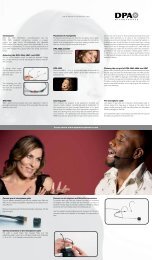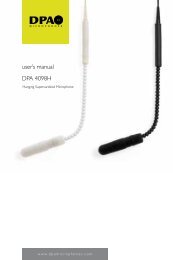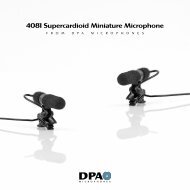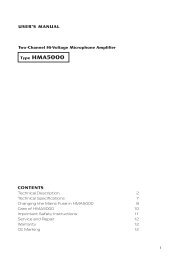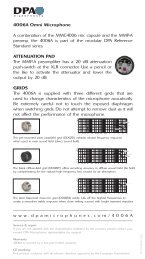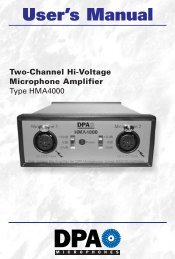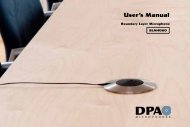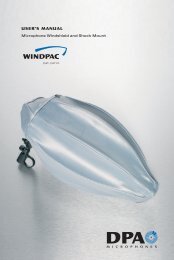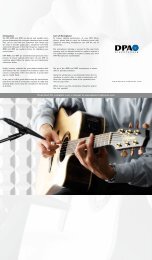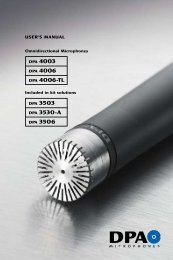Les Mis at the O2 - DPA Microphones
Les Mis at the O2 - DPA Microphones
Les Mis at the O2 - DPA Microphones
Create successful ePaper yourself
Turn your PDF publications into a flip-book with our unique Google optimized e-Paper software.
ON THE ROAD: <strong>Les</strong> <strong>Mis</strong> <strong>at</strong> <strong>the</strong> <strong>O2</strong><br />
LES MIS AT THE <strong>O2</strong><br />
LOUISE STICKLAND REPORTS FROM THE GREENWICH<br />
PENINSULA ON THE ARENA PRODUCTION THAT<br />
CELEBRATED 25 YEARS OF ONE OF THE WORLD’S MOST<br />
POPULAR THEATRE MUSICALS...<br />
Skills, resources, knowledge and style from<br />
both <strong>the</strong><strong>at</strong>re and rock’n’roll production<br />
disciplines were united to stage a very<br />
special 25th anniversary production of <strong>the</strong><br />
legendary Boublil & Schönberg musical <strong>Les</strong><br />
<strong>Mis</strong>érables <strong>at</strong> London’s <strong>O2</strong> Arena, with<br />
producer Cameron Mackintosh laying some<br />
serious technical challenges on <strong>the</strong> table.<br />
It was a large and very high profi le one-off<br />
version of <strong>the</strong> epic show, following a short<br />
celebr<strong>at</strong>ory run <strong>at</strong> <strong>the</strong> original venue, <strong>the</strong><br />
Barbican, and <strong>the</strong> pressure was on to present it<br />
to all <strong>the</strong> standards of excellence expected from<br />
one of <strong>the</strong> most popular world class <strong>the</strong><strong>at</strong>re<br />
works of all-time.<br />
As Mackintosh said himself: “With a Victor<br />
Hugo novel as <strong>the</strong> base of this, this is <strong>the</strong> best<br />
story for any musical ever. The brilliant, brilliant<br />
score m<strong>at</strong>ches <strong>the</strong> story and it’s become a sort<br />
of timeless piece th<strong>at</strong> every gener<strong>at</strong>ion has<br />
fallen in love with and comes back to again and<br />
again.”<br />
52 • TPi NOVEMBER 2010
ON ON THE THE ROAD: ROAD: <strong>Les</strong> Mallorca <strong>Mis</strong> <strong>at</strong> <strong>the</strong> Rocks<br />
<strong>O2</strong><br />
Immedi<strong>at</strong>ely following a brief, two-week<br />
run <strong>at</strong> <strong>the</strong> original <strong>Les</strong> <strong>Mis</strong> venue, <strong>the</strong> barbican,<br />
this one-off, three hour long 25th anniversary<br />
concert present<strong>at</strong>ion fe<strong>at</strong>ured more than 500<br />
actors and musicians including Alfie Boe as ‘Jean<br />
Valjean’, Nick Jonas (of <strong>the</strong> Jonas Bro<strong>the</strong>rs) as<br />
‘Marius’, Norm Lewis as ‘Javert’, M<strong>at</strong>t Lucas as<br />
‘Thenardier’, Lea Salonga as ‘Fantine’, Jenny<br />
Galloway as ‘Madame Thenardier’ and K<strong>at</strong>ie<br />
Hall as ‘Cosette’.<br />
They were joined by members of <strong>the</strong><br />
original 1985 cast including Michael Ball, Alun<br />
Armstrong and Colm Wilkinson.<br />
Preceded by a short production rehearsal<br />
period <strong>at</strong> <strong>the</strong> new LH2 Studios facility in Park<br />
Royal, north-west London, <strong>the</strong> initial load in to<br />
<strong>the</strong> <strong>O2</strong> was followed by two days of technical<br />
rehearsals. Th<strong>at</strong> in itself would have been<br />
straightforward enough, even on <strong>the</strong> large scale<br />
th<strong>at</strong> it was, but this was where it started getting<br />
interesting.<br />
The whole production had to be de-rigged<br />
and taken out to allow a Santana concert to<br />
take place on <strong>the</strong> Friday night. It <strong>the</strong>n loaded<br />
back in first thing S<strong>at</strong>urday, ready for more<br />
technicals and a full dress run th<strong>at</strong> evening,<br />
Above L-R: Lighting designers Paule Constable & P<strong>at</strong>rick Woodroffe; sound designer Mick Potter.<br />
followed by <strong>the</strong> two sold-out shows <strong>the</strong><br />
following day.<br />
Nick Levitt — whose production industry<br />
credentials need no introduction — was<br />
brought onboard by <strong>the</strong> Cameron Mackintosh<br />
production team (led by Jerry Donaldson)<br />
to amalgam<strong>at</strong>e <strong>the</strong> techniques and working<br />
methods of two very different production<br />
genres and make <strong>Les</strong> <strong>Mis</strong> work in an arena.<br />
With this, came his wealth of leading<br />
contractor contacts and vast experience of <strong>the</strong><br />
logistics involved and parameters needed to<br />
make special events really rock.<br />
RIGGING<br />
Summit Steel supplied all <strong>the</strong> rigging equipment<br />
and trussing for over-stage and audience<br />
lighting, mo<strong>the</strong>r grids, surround and support<br />
for <strong>the</strong> screens, plus all motors and a Kinesys<br />
system.<br />
Summit Steel’s project manager, Jon Bray<br />
and Nick Levitt have known and worked with<br />
each o<strong>the</strong>r for over 30 years, and so Levitt<br />
brought <strong>the</strong> firm into <strong>the</strong> equ<strong>at</strong>ion early on with<br />
Richard Wy<strong>the</strong>s leading its crew. A happy and<br />
convenient coincidence was th<strong>at</strong> Summit is also<br />
<strong>the</strong> venue’s house rigging services provider.<br />
“You can do pretty much anything if <strong>the</strong>re is good communic<strong>at</strong>ion between all parties<br />
and if it’s planned and sufficiently thought-through well and in advance...” Jon Bray<br />
<br />
<br />
<br />
<br />
<br />
<br />
<br />
<br />
<strong>DPA</strong> The<strong>at</strong>re TP 190 x 136.indd 1 02/11/10 14.38<br />
TPi NOVEMBER 2010 • 53
ON THE ROAD: <strong>Les</strong> <strong>Mis</strong> <strong>at</strong> <strong>the</strong> <strong>O2</strong><br />
Bray started working well in advance with<br />
lighting crew chief Rich Gorrod, on a l<strong>at</strong>eral<br />
thinking str<strong>at</strong>egy toge<strong>the</strong>r with Levitt and colighting<br />
designers Paule Constable and P<strong>at</strong>rick<br />
Woodroffe. The way <strong>the</strong> lighting rig in particular<br />
was designed was critical to whe<strong>the</strong>r moving<br />
<strong>the</strong> show in and out in time would be feasible<br />
and possible.<br />
“You can do pretty much anything if <strong>the</strong>re<br />
is good communic<strong>at</strong>ion between all parties and<br />
it’s planned and sufficiently thought-through<br />
well and in advance,” said Bray, who quietly<br />
relishes <strong>the</strong>se galvanising tasks.<br />
Th<strong>at</strong> PRG Lighting and Summit are part<br />
of <strong>the</strong> same group of companies helped<br />
enormously in terms of fluid and easy<br />
communic<strong>at</strong>ions, along with Summit’s<br />
rel<strong>at</strong>ionship and role with <strong>the</strong> <strong>O2</strong>, and<br />
consequent intim<strong>at</strong>e knowledge of <strong>the</strong> building<br />
and its working practices.<br />
In addition, elucid<strong>at</strong>ed Bray, Santana’s<br />
production crew were also extremely friendly<br />
and accommod<strong>at</strong>ing, Had this not been <strong>the</strong><br />
case, <strong>the</strong>re could have been a few potential<br />
stumbling blocks.<br />
Key to meeting all of <strong>Les</strong> <strong>Mis</strong>érables’<br />
deadlines, <strong>the</strong> major time-saving solution was<br />
to rig as much of <strong>the</strong> <strong>Les</strong> <strong>Mis</strong> production as<br />
high as possible in <strong>the</strong> roof, and this <strong>the</strong>y were<br />
able to do with eight of <strong>the</strong> high lighting trusses<br />
and two mo<strong>the</strong>r grids — primarily also used for<br />
lighting positions — which were all hung on<br />
30m (motor) chains.<br />
This allowed <strong>the</strong>m to be flown out into <strong>the</strong><br />
roof, dead hung and left in unseen for Santana.<br />
The rear lighting trusses and all <strong>the</strong> PA effects<br />
stacks and delays were also hung high, so <strong>the</strong>y<br />
didn’t need to be removed.<br />
This left <strong>the</strong> main left and right PA hangs,<br />
two substantial sub-bass hangs, eight lower<br />
lighting ‘Barricade’ and ‘Buttress’ trusses (which<br />
doubled as scenery in addition to providing<br />
lighting positions), all on a Kinesys autom<strong>at</strong>ion<br />
system, and one additional truss to come out.<br />
DOUBLE DECKER<br />
The set was designed by M<strong>at</strong>t Kinley. A large<br />
scaffolding double decker stage was installed<br />
Top: Original CAD renderings of <strong>the</strong> set. Above L-R: M<strong>at</strong>t Lucas; Jenny Galloway; Herbert Kretzmer, Alain Boublil & Claude-Michel Schonberg.<br />
54 • TPi NOVEMBER 2010
ON THE ROAD: <strong>Les</strong> <strong>Mis</strong> <strong>at</strong> <strong>the</strong> <strong>O2</strong><br />
Below L-R: The four Jean Valjeans — Simon Bowman, Alfie Boe, Colm Wilkinson and John Owen-Jones; Susan Jane Tanner (<strong>the</strong> original Madame Thenardier) & Alun Armstrong (original Thenardier); <strong>the</strong><br />
girls went crazy for Jonas Bro<strong>the</strong>r, Nick (far right).<br />
“It’s become a sort of timeless piece th<strong>at</strong> every gener<strong>at</strong>ion has fallen in<br />
love with and comes back to again and again...” Cameron Mackintosh<br />
by Star Events, which extended<br />
upwards 5m high <strong>at</strong> <strong>the</strong> back and<br />
was built in to <strong>the</strong> <strong>O2</strong>’s highest<br />
levels of se<strong>at</strong>ing.<br />
Three Flyer 18 LED mesh<br />
screens supplied by Cre<strong>at</strong>ive<br />
Technology were installed left,<br />
right and centre on-stage,<br />
presenting Summit’s next brain<br />
teaser: how to easily rig <strong>the</strong>se<br />
over <strong>the</strong> stage above <strong>the</strong> upstage<br />
se<strong>at</strong>ing tribunes.<br />
It was managed by assembling<br />
<strong>the</strong> screens on <strong>the</strong> ground, and<br />
‘motor bridging’ <strong>the</strong>m, continuing<br />
to build as <strong>the</strong>y were lifted in<br />
London’s Premier Entertainment<br />
Production Facility<br />
31.5m (103’) Wide / 44m (144’) Long / 18.1m (60’) High<br />
Concord Road, London, W3 0SE<br />
T: +44 208 752 0440 F: +44 208 752 3055 Mob: +44 7584 345 343<br />
Contact: Derek Fudge E: derek.fudge@lh2studios.co.uk<br />
www.lh2studios.co.uk<br />
stepped stages and walked back<br />
up over <strong>the</strong> stage until <strong>the</strong>y<br />
reached <strong>the</strong> back, after which <strong>the</strong>y<br />
were drifted up into position above<br />
<strong>the</strong> se<strong>at</strong>s, an oper<strong>at</strong>ion utilising 19<br />
two tonne motors.<br />
The screens were also hung<br />
on beams th<strong>at</strong> are not normally<br />
utilised by <strong>the</strong> <strong>O2</strong> in its standard<br />
concert set up, so this involved<br />
a lot of extra interaction and<br />
testing with <strong>the</strong> venue’s structural<br />
engineers.<br />
LIFTING GEAR<br />
<strong>Les</strong> <strong>Mis</strong> <strong>at</strong> <strong>the</strong> <strong>O2</strong> was <strong>the</strong> first<br />
major event for PRG Lighting’s<br />
new Kinesys DigiHoist 8 controller,<br />
a product specially developed by<br />
Kinesys to replace all PRG UK’s<br />
existing hoists and standardise<br />
<strong>the</strong>ir stock with a robust and<br />
flexible new interface. The<br />
DigiHoist is now also available<br />
from Kinesys’ off <strong>the</strong> shelf product<br />
range.<br />
In total, <strong>the</strong> rigging point<br />
count was 147, 44 of which were<br />
consumed by audio (supplied by<br />
Autograph), with 24 on <strong>the</strong> main<br />
hangs and 20 on <strong>the</strong> 10 delay<br />
positions which needed two<br />
points each to give <strong>the</strong> required<br />
focusability. The o<strong>the</strong>r 68 were<br />
utilised for lighting, including<br />
audience trusses installed to<br />
illumin<strong>at</strong>e <strong>the</strong> crowds for <strong>the</strong> live<br />
DVD shoot.<br />
The trusses were scenically<br />
tre<strong>at</strong>ed on-site by CTS The<strong>at</strong>rical<br />
Services, a division of <strong>the</strong> Welsh<br />
N<strong>at</strong>ional Opera, in an oper<strong>at</strong>ion<br />
overseen by Craig Tucker, who also<br />
took care of stage dressing.<br />
These elements flew in<br />
dram<strong>at</strong>ically <strong>at</strong> <strong>the</strong> top of <strong>the</strong><br />
second act, resting <strong>at</strong> jaunty angles<br />
to cre<strong>at</strong>e those famous Parisian<br />
revolutionary street scenes, in a<br />
flourishing move achieved using 16<br />
axes of Kinesys autom<strong>at</strong>ion on half<br />
tonne Lodestars, plus two axes of<br />
encoded Kinesys beam trolleys.<br />
The Kinesys system was oper<strong>at</strong>ed<br />
by Gareth Williams using Kinesys’<br />
proprietary Vector Control.<br />
As a dram<strong>at</strong>ic show opener,<br />
<strong>the</strong> two Buttresses were raised<br />
from horizontal to 70°, forming<br />
a pros arch effect. This utilised a<br />
Kinesys beam trolley <strong>at</strong>tached to<br />
<strong>the</strong> upstage points, which moved<br />
and kept everything in place as<br />
<strong>the</strong> downstage motors began to<br />
lift <strong>the</strong> ‘top’ end of <strong>the</strong> trusses via<br />
encoded Lodestars.<br />
MOVING IMAGE<br />
Video was designed by 59<br />
Productions (Leo Warner), who<br />
also designed <strong>the</strong> content for <strong>the</strong><br />
current UK touring <strong>Les</strong> <strong>Mis</strong>érables<br />
show, with all <strong>the</strong> screen, camera<br />
switching and production<br />
equipment supplied by Cre<strong>at</strong>ive<br />
Technology, and project managed<br />
by Stuart Young and Scott Burges.<br />
Visions Mobile supplied an OB<br />
truck and 16 cameras for <strong>the</strong> DVD<br />
shoot.<br />
The total screen area was 252<br />
modules of Flyer 18, CT’s new<br />
lightweight 18mm LED display,<br />
configured as <strong>the</strong> three screens.<br />
Playback m<strong>at</strong>erial was stored on<br />
two fully flightcased C<strong>at</strong>alyst<br />
V4 Pro systems, run from a Hog<br />
iPC console oper<strong>at</strong>ed by Steve<br />
56 • TPi NOVEMBER 2010
ON THE ROAD: <strong>Les</strong> <strong>Mis</strong> <strong>at</strong> <strong>the</strong> <strong>O2</strong><br />
‘Spooky’ Parkinson and supplied to CT by SNP<br />
Productions. All screen outputs were routed via<br />
a Christie Vista Spyder run by Dean Turner.<br />
CT also provided a Snell & Wilcox Kahuna<br />
vision mixing system th<strong>at</strong> took split camera<br />
feeds from <strong>the</strong> Visions truck, which were<br />
directed for <strong>the</strong> live show screens by Larne<br />
Poland, who <strong>the</strong>n sent a three-camera output<br />
I-Mag mix to <strong>the</strong> Spyder for outputting to <strong>the</strong><br />
screens. All <strong>the</strong> video production was removed<br />
and re-rigged for <strong>the</strong> Santana show.<br />
AUDIO<br />
Mick Potter, <strong>the</strong> sound designer of <strong>the</strong> West<br />
End production of <strong>Les</strong> <strong>Mis</strong> and <strong>the</strong> touring<br />
shows, continued his role <strong>at</strong> <strong>the</strong> <strong>O2</strong>, as did<br />
audio supplier, Autograph, in an oper<strong>at</strong>ion coordin<strong>at</strong>ed<br />
by senior hire production engineer,<br />
Jim Douglas.<br />
As always, it was a complex show for sound,<br />
specially given <strong>the</strong> out-of-<strong>the</strong><strong>at</strong>re context. The<br />
main speaker hangs were Meyer Milo speakers<br />
— a left and right of 18 speakers each and <strong>the</strong>n<br />
two side hangs of 10 each.<br />
There were both flown and floor subs — a<br />
total of 24 Meyer 700 HPs, which is a somewh<strong>at</strong><br />
serious amount, needed because of <strong>the</strong><br />
barricades and <strong>the</strong> need to have <strong>the</strong> headroom<br />
to make <strong>the</strong> air move without any distortion.<br />
A supplementary centre cluster array of 10<br />
Meyer Mica speakers filled in down <strong>the</strong> middle<br />
of <strong>the</strong> stalls, and <strong>the</strong>n <strong>the</strong>re were eight drops of<br />
four Micas as delays, and a pair of UPQs under<br />
each drop in a horseshoe shape snaking around<br />
above <strong>the</strong> raked se<strong>at</strong>ing for surround FX. The<br />
main delays were two fur<strong>the</strong>r arrays of 10 Micas<br />
positioned halfway up <strong>the</strong> arena floor.<br />
There were around 60 wedges and front<br />
fills (a mix of d&b E0s and E3s and Meyer UPJs).<br />
Fourteen Meyer UM100P monitors were built<br />
into <strong>the</strong> stage floor.<br />
The Meyer Galileo system was utilised for<br />
all <strong>the</strong> processing, time alignment and EQ,<br />
and a SIM 3 audio analyser was used for all<br />
<strong>the</strong> real-time measurement calcul<strong>at</strong>ions, dealt<br />
with by Andy Brown along with all <strong>the</strong> audio<br />
networking, which used Meyer’s RMS system.<br />
Meyer’s loudspeakers were all self-powered,<br />
with D6 amps driving <strong>the</strong> d&bs.<br />
The mic choice, consisting mostly of <strong>DPA</strong>s,<br />
numbered approxim<strong>at</strong>ely 150 specific units<br />
— a specific<strong>at</strong>ion th<strong>at</strong> required sub-hiring from<br />
Europe and <strong>the</strong> St<strong>at</strong>es. The <strong>DPA</strong> mics were<br />
mainly a combin<strong>at</strong>ion of 4061 mini<strong>at</strong>ure omnis<br />
and 4022 compact cardioids, with some 4011<br />
cardioids and 4007 omnis.<br />
Mick Potter has used <strong>DPA</strong>s on close to 100<br />
productions since S<strong>at</strong>urday Night Fever in<br />
1998; ei<strong>the</strong>r <strong>the</strong> <strong>DPA</strong> 4065 omni headband or<br />
<strong>the</strong> <strong>DPA</strong> 4061 mini<strong>at</strong>ure omnis on cast members<br />
depending on <strong>the</strong> type of show.<br />
“I’ve used <strong>the</strong>m for so long because <strong>the</strong>y<br />
sound much better than anyone else’s mini<br />
condensers,” he said.<br />
“S<strong>at</strong>urday Night Fever was one of <strong>the</strong> first<br />
major uses of <strong>the</strong> 4065 once it had gone into<br />
production, and we worked with <strong>DPA</strong> on issues<br />
such as resonance in <strong>the</strong> tubes and things<br />
bending r<strong>at</strong>her than breaking. They have a huge<br />
amount of gain before feedback for an omni<br />
mic while maintaining a transparent sound,<br />
which is critical in <strong>the</strong> <strong>the</strong><strong>at</strong>re with multiple<br />
omni mics open on stage. Everything needs to<br />
be set up around high gain before feedback, <strong>at</strong><br />
<strong>the</strong> same time maintaining a very n<strong>at</strong>ural vocal<br />
sound.<br />
“Doing Andrew Lloyd Webber shows you’re<br />
running mics <strong>at</strong> much more pretern<strong>at</strong>ural and<br />
dynamic levels than you might on a more<br />
n<strong>at</strong>uralistic show. Until <strong>DPA</strong> th<strong>at</strong> wasn’t really<br />
possible; o<strong>the</strong>r mics would sound much more<br />
ambient and colour <strong>the</strong> sound. The <strong>DPA</strong><br />
mini<strong>at</strong>ures are phenomenal in this respect.”<br />
At FOH, Paul G<strong>at</strong>ehouse used a DiGiCo<br />
SD7T console with an EX007 expansion unit,<br />
all run over Opticore fibre, with ano<strong>the</strong>r SD7T<br />
for monitors, engineered by Crispian Covell<br />
and Nick Gray. Tim Stephens was Autograph’s<br />
production sound engineer.<br />
Jim Douglas commented th<strong>at</strong> working with<br />
Summit Steel in <strong>the</strong> <strong>O2</strong> was an “excellent”<br />
experience. Autograph is used to working in<br />
<strong>the</strong><strong>at</strong>re venues where <strong>the</strong> sound focus has to be<br />
millimetre perfect, and arenas are a completely<br />
different ball game, so getting all <strong>the</strong> points<br />
spot-on was essential.<br />
Autograph’s hire manager Scott Arnold<br />
liaised with no less than 13 companies to pull in<br />
all <strong>the</strong> sub hires needed to ensure <strong>the</strong>y got <strong>the</strong><br />
exact kit th<strong>at</strong> Potter specified during a very busy<br />
period of <strong>the</strong> year, proving a really challenging<br />
set of logistics for a one-off.<br />
LIGHTING<br />
P<strong>at</strong>rick Woodroffe and Paule Constable worked<br />
with <strong>the</strong>ir associ<strong>at</strong>es Adam Bassett, Miriam<br />
Evans and Nick Simmons on <strong>the</strong> <strong>O2</strong> show<br />
lighting design.<br />
Additional lighting for <strong>the</strong> DVD shoot<br />
was designed by Steve Nolan, and all lighting<br />
equipment was supplied by PRG, co-ordin<strong>at</strong>ed<br />
by account handler Peter Marshall. The lighting<br />
crew chief was Rich Gorrod. The programmer/<br />
oper<strong>at</strong>ors were Andy Voller for <strong>the</strong> main show<br />
and Mike ‘Oz’ Owen for <strong>the</strong> audience and DVD<br />
shoot lighting.<br />
The stage lighting included over 200 moving<br />
lights — a mix of Vari*Lite VL3000 Spots,<br />
VL3500 Washes, VL5s, VL6Cs and VL1000 Arc<br />
shutter Spots; PRG Bad Boys, Clay Paky Alpha<br />
Beams and Martin Pro MAC 250s, plus a large<br />
conventional rig, which was programmed by<br />
Voller on two PRG V676 consoles.<br />
The audience system included 40 MAC 2000<br />
Washes, 39 VL3000 Spots and 26 VL2000<br />
Washes toge<strong>the</strong>r with bars of six PARs and 4-lite<br />
Moles, programmed by Owen on two Virtuoso<br />
consoles.<br />
Peter Marshall was also involved in <strong>the</strong> 10th<br />
anniversary <strong>at</strong> <strong>the</strong> Albert Hall and could hardly<br />
believe th<strong>at</strong> 15 years had flown by so quickly!<br />
The <strong>O2</strong> show was beamed live to nearly 200<br />
cinemas in <strong>the</strong> UK and Europe. This month, on<br />
November 17, a film of <strong>the</strong> performance will be<br />
screened in nearly 500 U.S. cinemas. Here’s to<br />
<strong>the</strong> next quarter of a century!<br />
TPi<br />
Photography by<br />
Dan Wooller & courtesy of<br />
Cameron Mackintosh Limted © 2010<br />
58 • TPi NOVEMBER 2010




